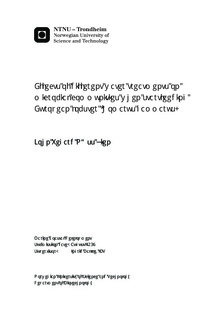Effects of different water treatments on microbial communities when startfeeding European lobster (Homarus gammarus)
Master thesis
Permanent lenke
http://hdl.handle.net/11250/2353893Utgivelsesdato
2014Metadata
Vis full innførselSamlinger
Sammendrag
The challenge with poorly performing larvae and high mortality in replicate tanks is a bottleneck in aquaculture. The main objective of this thesis has been to reveal if differences in performance and survival of the reared larvae is caused by instability in the microbial communities in the rearing water, and furthermore to investigate if disinfection devices also contribute to this instability and work against its purpose, which is to increase the level of performance and survival. The European lobster (Homarus gammarus) was used in the experiment because this species is subject to a lot of research today.
Two recycling aquaculture systems (RAS), of which one included an ultraviolet filter (UV filter) and one flow-through system (FTS) with no UV filter were compared. The samples were analysed using a PCR (Polymerase chain reaction) and DGGE (Denaturing gradient gel electrophoresis) strategy and tested statistically for variations between the systems. Samples were taken from intake water, rearing water and from whole larvae. There were indications that the water treatment influenced the microbial communities in both water and larvae of the systems. RAS with no UV filter presented the highest rate of survival and showed the most similar microbiota between intake water and rearing water. The RAS with UV filter and FTS both showed significant differences between intake water and rearing water, creating a room for regrowth for bacteria. This study support the hypothesis that r-strategic bacteria will be favoured in unstable systems and create opportunity for pathogens to dominate the waters, resulting in less optimal conditions for the reared organism. It also supports the theory that using disinfection on the water before entering the rearing systems will lower the total bacteria concentration and may create instability and room for re-growth.
The experiment was executed at the Norwegian Unicersity of Science and Technology (NTNU) with participation from, Sintef fisheries and aquaculture and Norsk hummer AS. Live-feed experiment was performed at NTNU Brattøra and the laboratory work was done at NTNU Gløshaugen. The live-feed was produced by Sintef Fisheries and Aquaculture, and the lobster larvae were produced at Norsk Hummer AS, Tjeldbergodden.
